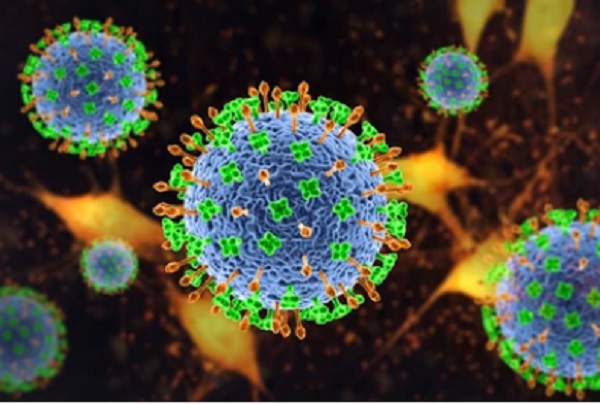Nipah virus re-emerges in India, 6 cases infected, 2 deaths
Specialist Doctor 2 Nguyen Minh Tien, Deputy Director of the City Children's Hospital (HCMC), said that Nipah virus is a type of virus that causes infectious diseases transmitted from animals to humans. Malaysia and Singapore are the two countries that recorded the first outbreak of Nipah virus in 1998-1999 in humans and pigs. Then came Bangladesh, West Bengal (India) in 2001, Philippines in 2014, in Kerala (India) in 2018 and recurred as it is now.
In the past week, the Nipah virus outbreak in the southern Indian state of Kerala has seen six cases of the virus, including two deaths and one on a ventilator, a 9-year-old boy. More than 700 people, including health workers, have been tested. The Indian state government has taken emergency steps to contain the spread of the Nipah virus, including closing some schools, offices and public transport networks.
Fast spreading speed
Dr. Tien said that according to the epidemiological history, the disease caused encephalitis symptoms in pig farmers in the Nipah village in Malaysia, so the virus was named after the Nipah village in Malaysia. Initially, the Malaysian health authorities mistook it for Japanese encephalitis, however, epidemiological records of those infected showed that many had been vaccinated against Japanese encephalitis. Moreover, the disease has some symptoms that are not similar to Japanese encephalitis, often appearing in adults, and clusters of cases living in the same house and on the same farm, so the authorities suspect that it is caused by another virus transmitted from pigs.
Based on the results of isolation from urine, people found antibodies against Nipal virus in bats in Bangladesh, the east coast of Malaysia...
The antibody was later found in the blood of 23 species of bats, living in Yunnan and Hainan Island (China), Cambodia, Thailand, Indonesia, Madagascar, and Ghana in West Africa.
“Nipah virus belongs to the Paramyxoviridae family, Henipavirus genus, and has an RNA nucleus, so it spreads faster than viruses with a DNA nucleus,” Dr. Tien shared.

Nipah virus belongs to the family Paramyxoviridae
Incubation period from 7-40 days, mortality rate 40-70%
Nipah virus can be transmitted in 3 ways: directly from bats to humans, or through an intermediary through bat food, from bats to other animals via humans, from infected people to humans via urine, saliva, throat secretions, through droplets, directly or indirectly through contact with care, infected objects...
People infected with Nipah virus mainly show symptoms in the nervous and respiratory systems. Some patients have no symptoms. The incubation period is 7-40 days, so it is easy to miss during surveillance.
"The initial symptoms are usually sudden fever, headache, muscle pain, nausea, vomiting, brain signs such as stiff neck, photophobia, cough, difficulty breathing, chest pain, and lung damage on X-ray. In addition, infected people may have heart damage and changes in heart muscle function. About 60% of cases progress rapidly, worsen, and fall into a coma within 5-7 days. Generalized convulsions occur in 20% of patients," Dr. Tien shared.
Symptoms that show signs of severe progression include the appearance of muscle tremors in the upper limbs, neck muscles, diaphragm, cerebellar disorders (loss of coordination, staggering, limb tremors, loss of reflexes, brain stem damage, causing small pupils that do not react to light, abnormal doll's eye reflex), rapid heart rate, high blood pressure...
Some cases initially have no symptoms or mild symptoms, then late neurological symptoms, fever, headache, convulsions, magnetic resonance imaging (MRI) shows scattered plaque lesions throughout the brain, the patient has a state of prolonged fatigue, sleep disorders.
Patients infected with Nipah virus will have bone marrow samples taken for PCR testing to find the agent and biochemical tests will show increased cells (mostly lymphocytes), increased protein...
Specialist Doctor Vo Thi Huynh Nga, Department of Internal Medicine, Nam Sai Gon International General Hospital, said that the main host of the disease is a fruit bat species, the virus from this bat species will be transmitted to a number of other animals such as dogs, cats, pigs, goats... When we come into direct contact or eat food containing the fluids of animals carrying the disease, there is a high possibility that we have been infected with the Nipah virus. In addition, the disease can also be transmitted from person to person.
The disease is easily confused with other diseases with atypical symptoms such as sore throat, cough, fever, difficulty breathing, headache, vomiting. When in the severe stage, the patient will experience serious symptoms such as impaired perception, convulsions, coma, respiratory failure, encephalitis and can lead to death within the next 24-48 hours.
According to the World Health Organization (WHO), the mortality rate of NiV is 40-75%. This rate can vary from outbreak to outbreak depending on the local epidemiological surveillance and clinical management capabilities. The mortality rate recorded in Malaysia is 30-40%, in Bangladesh is 70%, in Kerala in 2018 the rate is up to 90%, meaning that out of 23 cases, only 2 survive.
Currently, there is no vaccine or specific treatment for Nipah virus disease. Therefore, monitoring and preventing the source of infection plays an important role.
Strengthening surveillance of immigrants
According to HCDC, Nipah virus disease has not been recorded in Vietnam. Currently, the Ho Chi Minh City health sector continues to monitor cases returning from epidemic areas. The health sector monitors people entering the country 24/7 at international border gates (Tan Son Nhat International Airport and Ho Chi Minh City Maritime Port) to promptly detect cases of fever or signs of suspected dangerous infectious diseases for timely isolation and treatment at the border gate, including strengthening the monitoring of people entering from areas with outbreaks.
HCDC also notes that passengers returning from epidemic areas, if they have suspected symptoms of the disease such as fever, headache for 3-14 days along with respiratory symptoms (cough, sore throat and difficulty breathing), should immediately contact a medical facility for timely advice and treatment.
Source link




![[Video] More than 100 universities announce tuition fees for the 2025–2026 academic year](https://vphoto.vietnam.vn/thumb/1200x675/vietnam/resource/IMAGE/2025/7/18/7eacdc721552429494cf919b3a65b42e)
























































































![[Infographic] In 2025, 47 products will achieve national OCOP](https://vphoto.vietnam.vn/thumb/402x226/vietnam/resource/IMAGE/2025/7/16/5d672398b0744db3ab920e05db8e5b7d)





Comment (0)